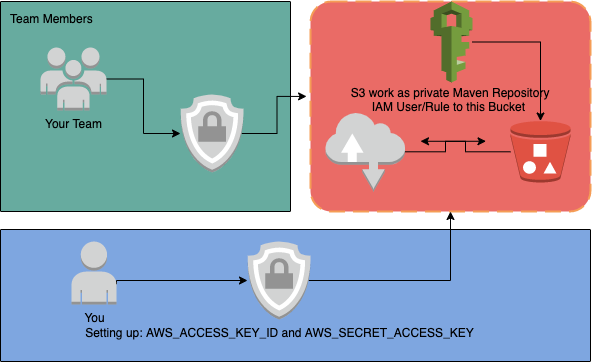maven-repository-aws-s3
Make AWS S3 Bucket as your private maven repository
View the Project on GitHub ehsaniara/maven-repository-aws-s3
maven-repository-aws-s3

Introduction With the help of this maven-plugin you can create your own private Maven Repository with the essential features. There are many commercial products out there, for example: Nexus, JFrog and ets.., but the drawback is they required more resources (Compute and storage) and some are costly. Where you can simply setup in your AWS cloud with much much less cost.

Start Here
- Configure AWS Pre-Req
- Configure By AWS CLI (No ready yet)
- Configure By AWS Console
- Local PC Setup
- CI/CD Pipeline Setup
- Reference
Configure AWS Pre-Req
First thing first, I assume you already have AWS account and with (Preferably Admin permission) permission to create IAM User, -Rule and -Policy.
You can use both AWS-CLI or Web Console (browser: https://aws.amazon.com/)
NOTE: Java 1.8 and 11 supporteds
Configure By AWS CLI:
Note: make sure that you have latest AWS CLI installed in your PC.
Note: make sure that you are in your project root directory and have permission to create a file.
```shell script curl -s https://raw.githubusercontent.com/ehsaniara/maven-repository-aws-s3/master/aws-s3-setup.sh | bash /dev/stdin bucket_name username
###### Note: Currently AWS CLI script is not completed, Please try AWS Console one
<a name="Configure-By-AWS-Console"></a>
## Configure By AWS Console
(browser: https://aws.amazon.com/)
<a name="Create-S3-Bucket"></a>
### Create S3 Bucket
create a AWS S3 bucket, try to have unique name from you domain, for example: ```my-project-com-maven-repository```
###### Note: Block all public access on the bucket
and also create 2 folder of ```release``` and ```snapshot``` in it.
<a name="Create-Policy"></a>
### Create Policy
Create policy with the following json (select json tab):
##### Note: dont forget to replace ```YOUR_BUCKET_NAME``` by your bucket name, for example: ```my-project-com-maven-repository```
```json
{
"Version": "2012-10-17",
"Statement": [
{
"Effect": "Allow",
"Action": [
"s3:PutObject",
"s3:GetObject",
"s3:CreateBucket",
"s3:ListBucket",
"s3:DeleteObject"
],
"Resource": "arn:aws:s3:::YOUR_BUCKET_NAME/*"
}
]
}
then give name to this policy. something similar to your bucket name, for example: my-project-com-maven-repository-policy and then create the policy.
Create IAM USER
on Add user, select a User name and make sure you have select the “Programmatic access”
then select “Attach existing policies directly”, and in Filter policies box search for your the policy name you have just created.
then tag,review and create the user.
Important: Make sure that you have download the .csv file and store it in the secure place. the credentials in this file is required to user in your ~/.m2/setting.xml file
create a user with (Programmatic access).
- create separate user to access your S3 bucket, for the security reason you should not give admin permission. this user should have enough access to read and write in the bucket and no more than that.
Note: you can have as many user (per team member) or single user just for repo access.
Local PC Setup
If you plane to deploy you project jar from your local machine you need to follow the following steps.
- on your local maven setup directory
.m2add the following XML snaps insetting.xml. you basically gave permission to maven to access the S3 bucket, to be able to push or pull the files. one for snapshot and one for release.
Note: create setting.xml if it’s not exist in .m2 directory
<settings>
<servers>
...
...
<server>
<id>YOUR_BUCKET_NAME-snapshot</id>
<username>AWS_ACCESS_KEY_ID</username>
<password>AWS_SECRET_ACCESS_KEY</password>
<configuration>
<region>AWS_REGION</region>
<publicRepository>false</publicRepository>
</configuration>
</server>
<server>
<id>YOUR_BUCKET_NAME-release</id>
<username>AWS_ACCESS_KEY_ID</username>
<password>AWS_SECRET_ACCESS_KEY</password>
<configuration>
<region>AWS_REGION</region>
<publicRepository>false</publicRepository>
</configuration>
</server>
....
....
</servers>
</settings>
- on your project
pom.xmladd the following xml to let maven DOWNLOAD your project artifactory from the maven-repo ```xml
##### Note: make sure that```<id>YOUR_BUCKET_NAME-snapshot</id>``` and ```<id>YOUR_BUCKET_NAME-release</id>``` should be identical with your ```.m2/setting.xml``` ids
* The following xml is required if you want ,user be able to upload into maven repo., from its terminal or idea
on your project ```pom.xml``` add the following xml to let maven **UPLOAD** your project artifactory into the maven-repo
```xml
<distributionManagement>
<snapshotRepository>
<id>YOUR_BUCKET_NAME-snapshot</id>
<url>s3://YOUR_BUCKET_NAME/snapshot</url>
</snapshotRepository>
<repository>
<id>YOUR_BUCKET_NAME-release</id>
<url>s3://YOUR_BUCKET_NAME/release</url>
</repository>
</distributionManagement>
And the most important one, add the following xml in your project pom.xml with in the <build> tag
<build>
...
<extensions>
<extension>
<groupId>com.github.ehsaniara</groupId>
<artifactId>maven-repository-aws-s3</artifactId>
<version>1.2.11</version>
</extension>
</extensions>
...
</build>
for Example:
<build>
<plugins>
<plugin>
<groupId>org.springframework.boot</groupId>
<artifactId>spring-boot-maven-plugin</artifactId>
<executions>
<execution>
<goals>
<goal>build-info</goal>
</goals>
</execution>
</executions>
</plugin>
<plugin>
<groupId>org.apache.maven.plugins</groupId>
<artifactId>maven-compiler-plugin</artifactId>
<version>3.8.1</version>
<configuration>
<release>11</release>
</configuration>
</plugin>
</plugins>
<extensions>
<extension>
<groupId>com.github.ehsaniara</groupId>
<artifactId>maven-repository-aws-s3</artifactId>
<version>1.2.11</version>
</extension>
</extensions>
</build>
once you have setup your pom.xml file in your project you can run the following line:
```shell script
to clean your target directory
mvn clean
deploy your artifactory into you maven-repo (AWS S3 Bucket)
mvn deploy ```
CI/CD Pipeline Setup
[updating soon..]
Reference
Apache wagon: http://maven.apache.org/wagon/

